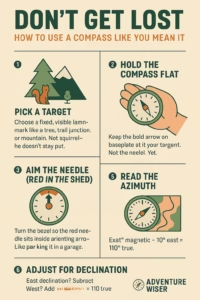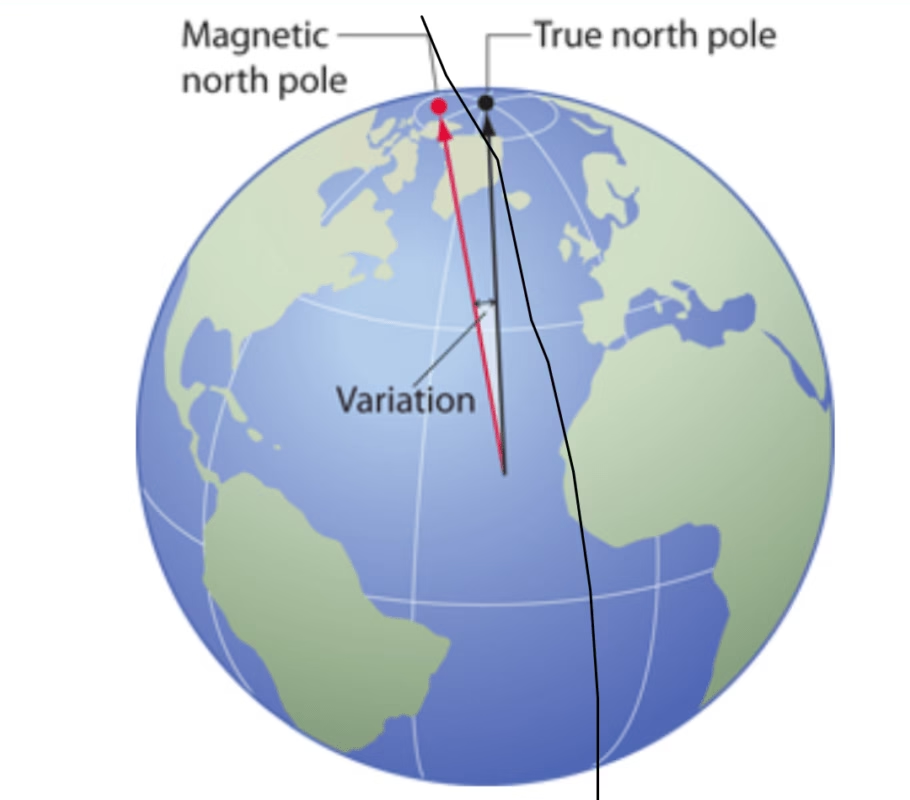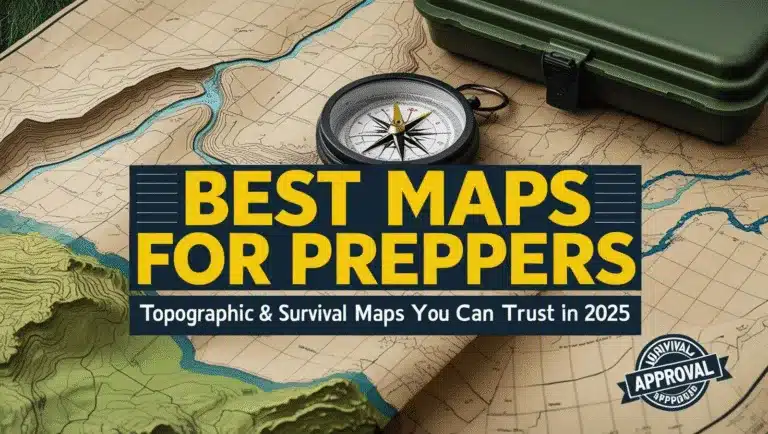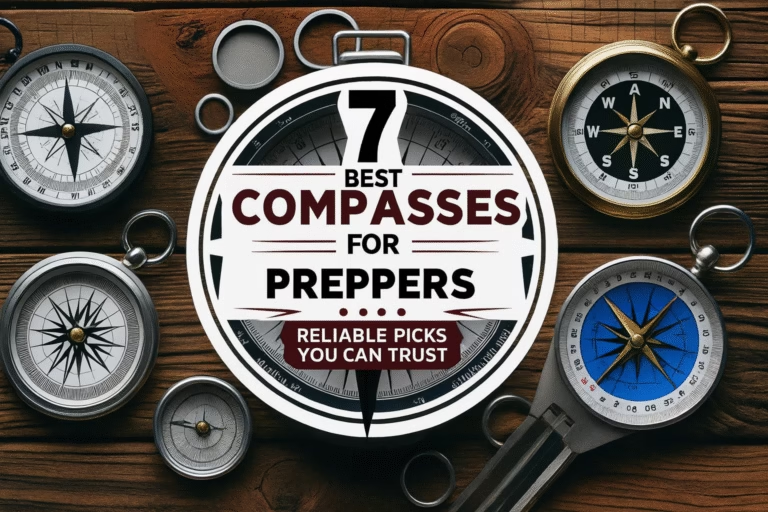
Magnetic Azimuths for Preppers: The Essential Guide to Mastering Bearings in 2025
Why You Should Care about magnetic azimuths
Ever notice how your GPS works flawlessly… right up until you actually need it? One dead battery, one blocked satellite signal, and suddenly your $1,200 smartphone is just a fancy brick. That’s when a skill most people forgot after Boy Scouts becomes the difference between “back home by dinner” and “three days headlined as a missing hiker.”
That skill? Knowing how to follow magnetic azimuths. Sounds technical, but really it’s just using a compass to point your boots in the right direction.
If you’re a prepper, hiker, hunter, or just someone who doesn’t want their eulogy to include the phrase “got lost within sight of the trailhead,” mastering magnetic azimuths is non-negotiable. This is one of those low-cost, high-survival-value skills that works whether satellites are online or the world’s gone dark.
In this guide, I’ll break down magnetic azimuths without the military jargon, show you step-by-step how to take and follow a bearing, and drop in the gear recommendations and sarcastic “don’t-do-this” warnings you’ll thank me for later.
What Is a Magnetic Azimuth?

A magnetic azimuth is basically your compass telling you, in cold hard numbers, which way you’re pointing. Think of it as the GPS coordinate’s tough, old-school cousin. Instead of saying, “Head toward that suspicious-looking oak tree until you’re hopelessly turned around again,” the compass spits out a precise number like 145°. That number is your bearing—the exact angle between your current position and magnetic north.
Why does this matter? Because the natural world doesn’t play nice. Trees fall, trails get overgrown, rivers flood, and “that one rock shaped like a turtle” somehow looks like every other rock when you’re tired, hungry, and cursing your life choices. Bearings, on the other hand, don’t care about your excuses. They give you a repeatable, universal way to stay on track whether you’re in the woods, desert, or a Walmart parking lot trying to find your car after blackout Tuesday.
In short: landmarks change. Bearings don’t. And if you’re serious about prepping, that kind of reliability is worth its weight in canned chili and spare ammo.
Reasons You Need to Know Magnetic Azimuths
- GPS Betrayal: Batteries die, signals fail, satellites get moody.
- Grid Down Scenarios: EMP, cyberattack, or just good old-fashioned phone drop in a creek.
- Military Roots, Civilian Benefits: Armies navigate with azimuths because they work. You should too.
- Prepper Insurance: Your bug-out bag isn’t complete if you can’t actually navigate with it.
Step-by-Step: How to Use Bearings Like a Pro

Step 1: Pick a Target
Don’t overthink this—just choose something you can actually see. A mountain peak, a trail junction, the edge of a ridgeline. Big, obvious, immovable stuff is your best friend. Do not pick the squirrel giving you side-eye from a stump. Squirrels move, and nothing ruins your survival swagger like chasing woodland creatures in circles.
Step 2: Hold the Compass Flat
Hold the compass at chest height, flat and steady, like you’re about to sacrifice it to the navigation gods. If the needle wobbles like a drunk pigeon at Mardi Gras, you’re either tilting the baseplate or standing next to metal (think belt buckles, cars, rifles, or that tactical fridge you swear was a good buy). Step back, steady your hands, and let the compass settle.
Step 3: Aim the Direction-of-Travel Arrow
See that bold arrow etched into the baseplate? That’s the “go that way, genius” arrow. Point it directly at your chosen landmark. Pro tip: this arrow does not move. Don’t confuse it with the needle. The needle spins. The baseplate arrow points. Mixing them up is how you end up starring in your own “lost hiker found two counties over” news story.
Step 4: Box the Needle (“Red in the Shed”)
Now twist the compass housing until the north end of the magnetic needle sits neatly inside the orienting arrow. In other words, put the red in the shed. That’s the universal compass-user handshake. When it’s boxed, you’ve officially locked in a bearing—welcome to the grown-up table of land navigation.
Step 5: Read the Bearing
Look down at the index line (that little mark at the edge of the housing). The number you see—say, 145°—is your magnetic azimuth. That’s your precise direction, not “kinda-sorta east.” Numbers don’t lie, even if your sense of direction does.
Step 6: Walk It Out
Here’s the fun part: start moving. Keep that needle boxed and your eyes on your target. But remember—terrain is a jerk. Hills, rivers, and deadfall will force you to detour. That’s fine. Just pause, re-aim at your target, and re-box the needle as you go. Also, check yourself every so often because fatigue, distraction, and your own two left feet can throw you off. Bearings are precise—humans, not so much.
When traveling long distances, pick “progressive landmarks” (like a series of trees, boulders, or ridgelines along your azimuth). That way you’re never walking blindly, and you can reset your bearing if you have to bushwhack around obstacles.
Key Considerations for Magnetic Azimuth

Going Further: Magnetic Declination
The earth’s magnetic north isn’t the same as true north — and the difference between them is called declination. Depending on where you are, that gap might be just a few degrees… or big enough to send you miles off course over long distances.
Ignore declination, and you’re not just “a little off” — you’re the proud owner of a wilderness detour you didn’t ask for. Learn how to adjust for declination if you want your bearings to actually mean something.
👉 I’ll be breaking this down in detail soon in Understanding Declination for Preppers (coming soon).
Alternatives and Backups
Even with a compass in hand, redundancy is a prepper’s best friend. Bearings are powerful, but combine them with backup tools to keep your navigation bulletproof.
- GPS: Fantastic… until your batteries die, your signal drops, or the satellites decide to ghost you. Never make it your only plan.
- Maps: Still the king of navigation. Plot your azimuths directly on a topo map and you’ll always have a visual check against your compass.
- Ranger Beads (Pace Counters): Bearings tell you where; ranger beads tell you how far. Combine the two and you’ve got direction and distance dialed in.
The smartest navigators don’t just rely on one method — they layer them. Compass bearings, pace count, and map markings create a system that’s accurate, repeatable, and resilient even when one tool fails.
Gear Callouts (Prepper-Grade Compasses)
If you’re serious about mastering azimuths, get a real compass, not the free toy that came in a Cracker Jack box.
- Suunto MC-2G: Rugged, accurate, and has a sighting mirror. My top pick for preppers.
- Silva Ranger 2.0: Perfect for map-and-compass navigation with declination adjustment.
- Cammenga 3H Tritium: Military-issue, glow-in-the-dark, and basically indestructible. (My favorite)
- Brunton TruArc 20: Solid backup with global needle.
Pro Tips from the Field
- Always shoot a back azimuth (180° opposite) so you can return the same way.
- Practice in daylight before you trust your skills in a storm.
- Write down bearings on your map instead of trusting memory.
- Two compasses are better than one. A backup in your glovebox weighs nothing compared to being lost.
FAQs
Q: Can’t I just follow trails instead of bearings?
A: Sure, until the trail forks, vanishes, or leads straight into “not where you want to be.” Bearings give you certainty.
Q: What’s the difference between a bearing and an magnetic azimuth?
A: Nothing that matters in the field. Bearing is the general direction, azimuth is the precise degree. Use them interchangeably unless you’re in a military exam.
Q: Do I need to practice with a map too?
A: Absolutely. A compass alone keeps you pointed, but combining map + azimuth makes you unstoppable.
Wrapping Up and My Experience
Learning magnetic azimuths isn’t just some old-school trick — it’s the backbone of real navigation. I learned the hard way, marching straight into a briar patch because I trusted my “sense of direction.” Spoiler: your gut isn’t half as reliable as a $50 compass.
Now, I don’t step into the woods without plotting a bearing. That little red needle turns uncertainty into confidence — and confidence is priceless. Could you wing it? Sure. But why gamble with your safety when the skill is simple, the tool is cheap, and the payoff is knowing you’ll never be the guy in tomorrow’s “lost hiker” headline?
👉 If you’re ready to level up your navigation game, check out my guide to the 5 Best Compasses for Preppers in 2025 — trusted picks that won’t let you down when it counts.
Field Note: My First Lost-Because-I-Knew-Better Moment
A few years back, I thought I was hot stuff with a new compass and a map I barely glanced at. I picked a “shortcut” through thick Arkansas pines and swore I was heading due north. Ten minutes in, I realized I was basically doing interpretive dance in circles. The only reason I found my way back was because I stopped, boxed the needle properly, and trusted the bearing instead of my “sense of direction.”
Lesson? Your gut lies. Your compass doesn’t. Unless you drop it on a rock. Then you’re both in trouble.
Heads-Up, Fellow Preppers:
Some links in this post are sponsored or affiliate links. If you click and buy, I may earn a small commission—enough to restock my peanut butter and maybe add one more can of chili to the stash. I only recommend gear I trust, use, and would hide in a bug-out bag.






